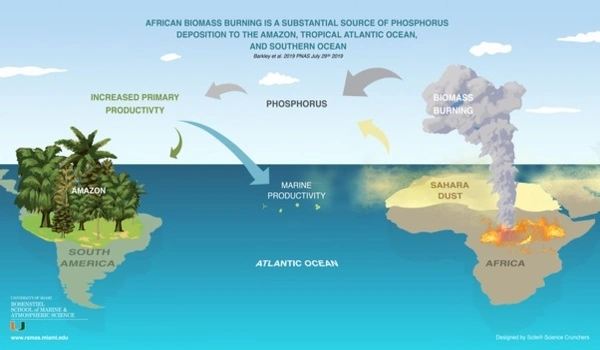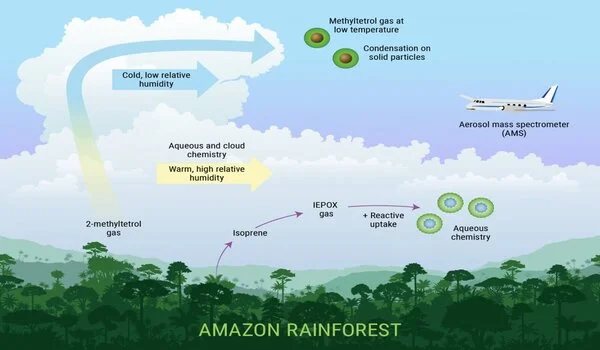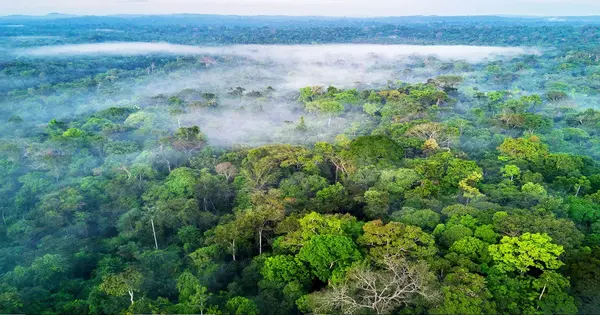According to a recent study by experts at Pacific Northwest National Laboratory, plant-foliage-derived chemicals generate a hitherto unknown meteorological phenomenon over the Amazon rainforest (PNNL).
The discoveries have significant implications for atmospheric research and climate change prediction.
“The tropical Amazon rainforest is the Earth’s lungs, and this work relates natural processes in the forest to aerosols, clouds, and the Earth’s radiative balance in previously unknown ways,” said Manish Shrivastava, PNNL Earth scientist and primary investigator of the study.
The research was just published in the journal ACS Earth and Space Chemistry.
“The tropical Amazon rainforest constitutes the lungs of the Earth, and this study connects natural processes in the forest to aerosols, clouds, and the Earth’s radiative balance in ways that have not been previously recognized,”
said Manish Shrivastava,
Filling in the blanks with missing data
Shrivastava and his colleagues were researching tiny particles in the upper atmosphere when they observed a significant difference between their results and what would have been expected based on existing atmospheric model assumptions. Further investigation revealed that crucial forest-atmosphere interactions were missing from current atmospheric models that determine the number of fine particles in the upper atmosphere.
The researchers found a previously unknown process involving semi-volatile chemicals generated by plants in the Amazon rainforest and transported into the upper atmosphere by clouds. These gases are natural carbon-based chemical compounds that condense easily in the high atmosphere to create fine particles. Shrivastava claims that this method is particularly efficient at creating fine particles at high elevations and cold temperatures. These small particles cool the earth by lowering the amount of sunlight that reaches it, and they also seed clouds, which influence precipitation and the water cycle.

Shrivastava added that “we simply cannot explain the presence and role of important particle components at high altitudes without a complete understanding of the semi-volatile source of organic gases.”
A significant breakthrough in atmospheric processes
Shrivastava’s research effort, which was financed by a Department of Energy (DOE) Early Career Research Award, entailed studying the development of aerosol particles known as isoprene epoxydiol secondary organic aerosols (IEPOX-SOAs), which are monitored by planes flying at various altitudes.
IEPOX-SOAs are crucial building components for fine particles found at all tropospheric altitudes—the region of the atmosphere stretching from the Earth’s surface to about 20 kilometers above tropical regions. However, atmospheric models failed to adequately account for these particles and their impact on clouds high above the Earth.
Because models were failing to anticipate reported IEPOX-SOA loadings at 10-to-14-kilometer elevations in the Amazon, we were obtaining what I thought were either model failures or a lack of understanding of the observations, Shrivastava explained. “I could explain it on the surface, but not at greater heights.”
Shrivastava and his colleagues combed through data obtained by the Grumman Gulfstream-159 (G-1) aircraft, a DOE flying laboratory maintained by the Atmospheric Radiation Measurement (ARM) Aerial Facility and capable of reaching altitudes of 5 kilometers. The researchers also examined data acquired by a German aircraft known as the High Altitude and Long Range Research Aircraft, or HALO, which can fly at an altitude of 14 kilometers. According to Shrivastava, their IEPOX-SOA loadings should have been at least an order of magnitude lower than what was measured. He and his colleagues outside of PNNL were unable to explain the discrepancy between the data and what the models predicted.
Prior to the team’s findings, it was thought that IEPOX-SOAs were generated predominantly by multiphase atmospheric chemistry routes involving isoprene in the gas phase and particles containing liquid water. On the other hand, the atmospheric chemistry processes required to produce IEPOX-SOAs do not occur in the high troposphere due to its extremely cold temperatures and dry circumstances. At that altitude, the particles and clouds are frozen and devoid of liquid water. As a result, using known models, researchers were unable to explain their development reported at altitudes ranging from 10 to 14 kilometers.
Prior to the team’s discovery, it was assumed that IEPOX-SOAs were primarily produced by multiphase atmospheric chemistry processes involving isoprene in the gas phase and particles containing liquid water in the liquid phase. Due to its extremely frigid temperatures and dry conditions, the atmospheric chemistry reactions required to create IEPOX-SOAs do not occur in the high troposphere. At that altitude, the particles and clouds are frozen and devoid of liquid water. As a result, experts were unable to explain the development reported at altitudes ranging from 10 to 14 kilometers using known models.
Shrivastava said that this is a significant discovery because it contributes to our understanding of how these small particles develop and, hence, sheds fresh light on how natural processes in the forest cool the planet and contribute to clouds and precipitation. In addition to a changing global climate and significant deforestation in many sections of the Amazon, humans are disrupting critical natural processes that produce fine particles in the atmosphere and moderate global warming.

Creating opportunities for more atmospheric research
According to Shrivastava, the team’s discovery merely scratches the surface of understanding this newfound atmospheric mechanism and how it affects the creation of tiny particles in the atmosphere. He believes the newly discovered plant activity could explain a wide range of atmospheric particle events in other forested areas throughout the planet.
In the broad scale of things, this is just the beginning of what we know,” he added, “and it will open up new research horizons in land-atmosphere-aerosol-cloud interactions.” “Understanding how the forest produces these particles may aid our understanding of how deforestation and changing climate may impact global warming and the water cycle.”





